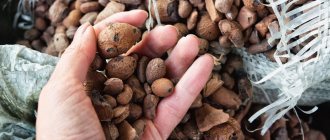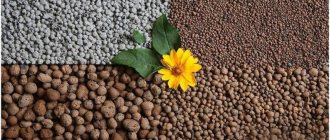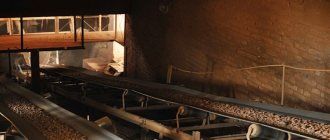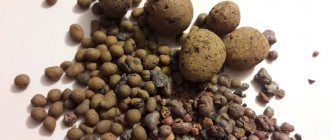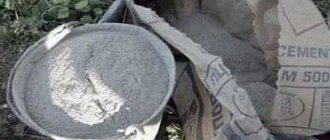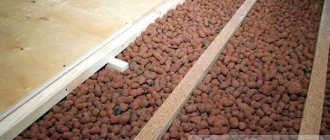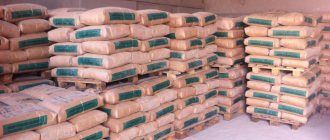How much does small expanded clay cost?
| Name of product | Packing | Small wholesale (from 0.5 cubic meters) |
| Expanded clay in bags, fraction 0-5 (Dry backfill) | Bag 0.05 cubic meters | 150 rub. per bag |
| Expanded clay in bags, fraction 5-10 | Bag 0.05 cubic meters | 115 rub. per bag |
| Expanded clay in bags fraction 10-20 | Bag 0.05 cubic meters | 84 rub. per bag |
| Expanded clay in bags, fraction 20-40 | Bag 0.05 cubic meters | 82 rub. per bag |
How much does 1 cube of expanded clay cost?
Prices for expanded clay
| Fraction | Volume | Price |
| Expanded clay in bulk Fraction 5-10 mm | 1 m³ | 1 700 rub. |
| Expanded clay in bulk Fraction 10-20 mm | 1 m³ | 1 200 rub. |
| Expanded clay in bulk Fraction 10-20 mm | 1 m³ | 1 650 rub. |
| Expanded clay in bulk Fraction 10-20 mm | 1 m³ | 1 900 rub. |
How much expanded clay is in a bag?
Expanded clay has long and firmly taken its place among building materials thanks to its unique composition - expanded clay. In industry, it is most often used for the production of lightweight concrete. In private construction, it is an indispensable material for foundations, floor and roof insulation, sound insulation and wall insulation. Inexpensive price and environmental friendliness are the main advantages for everyone who builds. There is a wide range of building materials that are necessary for the construction of a house or other objects. If you are now busy looking for a store where you can buy inexpensive expanded clay in bags, then by contacting our company, you can easily resolve the issue of purchase and prompt delivery.
Most construction and renovation work is carried out in confined spaces. It is extremely rarely possible to fit a ZIL or KAMAZ, unload, and promptly use an embankment in urban construction. The planning features of high-rise buildings, the customization of structures in courtyards, and the indefinite deadline for completion provoke the need to buy expanded clay packed in bags.
Advantages and disadvantages of the material
The advantages of the material include:
- Increased strength.
- Durability.
- Good thermal insulation.
- Frost resistance.
- Lightweight expanded clay.
- Fire resistance.
- Chemical inertness.
- Environmentally friendly.
- Low cost.
Advantages of expanded clay
The disadvantages of the substance are:
- Low acid resistance.
- Favorable environment for the reproduction of harmful insects.
This is interesting: Expanded clay block: dimensions, characteristics and classifications
Application and demand
Expanded clay is a material of natural origin in the form of sand or granules, which, in addition to construction work, finds its use in the most unpredictable areas of activity.
The constantly growing demand for expanded clay acts as a sales stimulator. Therefore, in construction stores, in addition to wholesale sales, customers are offered expanded clay packaged in bags.
Expanded clay has no restrictions on its use. Due to its decorative properties, it is in particular demand among designers. Expanded clay can successfully replace soil and soil mixtures in personal plots and vegetable gardens. It is used when laying out paths built on dense soils, when planning treatment facilities, etc.
Calculation of the amount of expanded clay
Quite often in retail outlets you can see the material only in loose form, sold in large volumes, for example, in cubic meters. Therefore, it is extremely important to carry out calculations in advance in order to get an answer to the question: How many cubes of expanded clay are in a bag? How to determine in advance the required number of bags to fill with expanded clay, how to organize the delivery of expanded clay?
Let's consider an approximate calculation of the amount of expanded clay:
For a 30 liter bag the calculation will look like this:
1000: 30 = 33.333 (bags), or in one bag there will be 30:1000 = 0.03 cubes of expanded clay.
By determining the exact number of bags for purchasing expanded clay, you can be sure that the purchase will be economical and meet your actual needs.
Source
What determines the price of the finished product?
The cost of the product depends on the fraction and weight of expanded clay, volumes of supplies, type of packaging, and transportation costs.
For your information. Regulatory documents allow products to be supplied in bulk and in packaged form. Multilayer paper or polyethylene bags should be used for packaging.
Technical characteristics of expanded clay
Wholesale price 1 m
3
material within the Moscow urban district is:
| No. | Fraction sizes, mm | Price for 1 m 3 , rub. |
| 1 | Over 20 to 40 | 2080 |
| 2 | Over 10 to 20 | 2080 |
| 3 | Over 5 to 10 | 3375 |
| 4 | up to 5 | 4424 |
The material is often used for thermal insulation of floors. There are more than 270 raw material production plants around the world. The annual production volume is over 73 million m
3
construction products.
Floor insulation with expanded clay - diagram
How much expanded clay fits in a bag?
It all depends on the volume of the bag and the density of the expanded clay. Standard bags are produced mainly with round capacities: 25, 30, 40, 50 and 60 liters. The size of the grains determines the density of the embankment. The smaller the diameter, the more grains enter the bag, the heavier the weight. Accordingly, on the contrary, the larger the grain, the smaller the piece quantity and the lighter the purchase volume. If we talk about average values, then a 25 liter bag holds 12 kg of medium-sized bulk substance (that is, the volume in liters is twice the mass in kilograms). These same 12 kg are the 40th part of 1 m 3 of bulk goods.
How much does expanded clay cost in bags?
Of course, somewhat more expensive than bulk goods. The costs of packaging and filling determine the additional markup. Example:
1 m 3 fractions 20–40 mm costs 1,400 rubles.
A bag with a capacity of 50 liters is 0.05 of a cube.
This means that an unpackaged volume of 50 liters should cost 1,400 rubles. × 0.05 = 70 rub.
It is worth adding about 20% to the indicated price (the cost of packaging and the bag itself). 70 rub. + 70 rub. × 20%: 100% = 84 rub. This is a logically justified cost of high-quality expanded clay in a bag.
Often promotional prices surprise with their low thresholds. It is quite possible to find a good product that is in stock, and the seller sells it at cost. But it happens that catchy promotional offers turn out to be the result of a trick with the weight or quality of expanded clay. Therefore, you should be picky about a product that attracts you with an advantageous offer. Savings on the purchase of building materials can be a significant loss on the costly outcome of construction.
How much does expanded clay weigh in bags?
The table shows exact weight calculations based on the density grade. The average below gives approximate values:
The average weight of 1 m 3 of expanded clay is about 450 kg.
One cubic meter holds about 20 bags with a volume of 50 liters.
Weight of one bag = 450 kg ꓽ 20 bags = 22.5 kg.
Why is it worth buying expanded clay?
Firstly, because it is a cheap and harmless material, resistant to corrosive and putrefactive processes. Porous granules provide excellent noise and heat insulation of structures. The best effect is achieved if a material with a large number of pores is used. They contain air that provides a cushion between two different temperature conditions. But large porous filler has little strength, which makes it impossible to use for foundations.
Throughout history, clay has served as a raw material for the manufacture of kitchen utensils and stoves. Moreover, ancient examples of bowls and jugs have survived to the present day. This indicates the wear resistance and durability of baked clay products. It is not attractive to rodents and insects. Does not react with acids, salts and alkalis.
Today, dry expanded clay screed is the fastest, cheapest and most convenient technology for creating a floor in a home in a couple of days. Moreover, the majority do without the involvement of additional specialists. Light weight allows you to insulate the roof. The minimum load between the floors provides sound insulation from neighbors and a warm base.
Source
Cement bag volume
In general, the question of how much cement is contained in a bag is not so easy to answer. Let's start with the fact that packaging comes in bags of 25 kg, 40 kg and 50 kg. So we need to clarify the mass. The second point is that cement comes in different forms. With or without additives. And additives also come in different types, and different types differ in density. This means that the same weight occupies a different volume.
The weight of a bag of cement can be 25 kg, 40 kg and 50 kg
There is one more point. The density of any cement changes over time. Immediately after production, when it was poured into bags, the density is the lowest. As the ground powder is poured in, the particles become charged and capture air molecules. Therefore, freshly poured it weighs less. During transportation and storage, the charge decreases, some of the air evaporates, and the density increases. So after a month more weight is placed in the same volume. Moreover, after about a year of storage, the difference with the bulk density is significant - up to 35% of the original value.
In the calculations, an average figure is taken, which is called specific density. For each type of cement it is different and in calculations when determining the amount of material required, you can build on it.
Calculation method
The specific density of cement is the mass of one cubic meter. For Portland cement, for example, it is 1300 kg/m³. To determine the volume of cement in a 50 kg bag, you need to solve a simple proportion:
How to calculate the volume of cement in a bag
We found what percentage of one cubic meter is contained in one 50 kg bag of Portland cement. This is 3.85%. This means that this container contains 0.0385 m³ (we simply “take a percentage” of the cubic meter).
Pivot table
For a bag of 25 kilograms, you can not count, but divide the resulting figure by two. One 25 kg bag of Portland cement contains 0.019 m³. For a 40 kg bag, you will have to calculate everything again. The result is 0.031 m³. Similar calculations must be done for all brands of cement with different densities. We did this and compiled the data into a table.
The table contains average values. If you know exactly the weight of a cube of your material (it can be indicated on the bag or you can weigh it and calculate it), it is better to recalculate. The difference is unlikely to be big, but still. How to calculate? Take a liter container, put it on the scales and weigh it. Pour cement - do not shake, do not compact. Just pour and weigh, and then take away the container weight. You will find how much a kilogram of cement you purchased weighs. Then you multiply by 1000 (one thousand liters in one cube) and you get the exact (almost) density of your material. You can use it later in calculations.
Volume weight
You can buy expanded clay with delivery in bags or in bulk; 1 m3 is used for measurement. Knowing the mass of the cube, it is easy to calculate the weight of a bag of material and, if necessary, the entire batch. It is almost impossible to calculate the exact weight of a certain number of granules without weighing; external factors influence it.
You can find out the average value, expanded clay weighs approximately 0.4 g/cm3 or 400 kg/m3, the weight of the bag is approximately 16.8 kg. For each fraction, the calculation is performed taking into account the values specified in GOST 32496-2013.
Where to buy expanded clay
Knowing the mass of 1 m3 of expanded clay granules, they calculate how much material is needed in total. It is more convenient to purchase the required quantity at. The quality of the products fully complies with the characteristics given in the relevant GOSTs. We supply the nonmetallic materials you need around the clock, any day of the week, including weekends and holidays.
There are no unforeseen delays - the organization has over 30 pieces of equipment that allow it to transport the required amount of cargo. The shipped goods undergo an examination before delivery. Its quality is confirmed by the necessary documents. We transport non-metallic materials to the construction site or to the gates of storage areas.
How much does a bag of expanded clay 0 5 weigh?
The specific gravity of expanded clay is the weight of a cube of expanded clay. Weight of 1m3 of expanded clay and its density
| Type of expanded clay | Specific gravity (g/cm3) | Expanded clay weight in 1 m3 (kg) |
| Fraction 0 – 5 mm, expanded clay sand | 0,55 – 0,6 | 550 — 600 |
| Fraction 5 – 10 mm | 0.4 – 0,45 | 400 – 450 |
| Fraction 10 – 20 mm | 0,35 – 0,4 | 350 – 400 |
| Fraction 20 – 40 mm | 0,25 – 0,35 | 250 — 350 |
How much concrete will be produced from a bag of cement?
Often proportions are indicated in volume fractions and therefore, when making calculations, it is useful to know how much concrete can be made from one bag of cement. But we need to talk about a specific brand and a specific concrete solution. The proportions are different and you need to decide on this first. The difference is significant - this can be seen from the following table.
How much concrete will be produced from 10 liters of cement?
For each binder and each brand, you will again have to count separately. For each concrete, the approximate consumption of cement for the production of one cube of mortar is known. Based on these data, you can calculate how much solution can be obtained from a kilogram of cement. Next, it is easy to find out the amount of concrete that can be obtained from a bag of cement.
Binder consumption by concrete grade
For example, a cube of M300 concrete requires 350 kilograms of M400 cement. That is, from one kilogram we get 1 m³ / 350 kg = 0.0028 m³. To find out how much M400 concrete you can get from a 50 kg bag, multiply by 50. We get 0.14 m³. As you can see, the calculations are simple.
To consolidate the information, let’s calculate for M200 mortar and the same M400 Portland cement. This type of concrete requires 250 kg. Then from a kilogram we get 1 cubic meter / 250 kg = 0.004 cubic meters. Then from 50 kg it will be: 0.004 * 50 = 0.2 cubic meters, from 40 kg - 0.004 * 40 = 0.16 cubic meters.
Source
